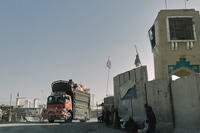The secretary of defense said Wednesday that the Pentagon is able to continue providing aid to Ukraine in its war against Russian invasion and also support Israel after a Hamas attack Saturday sparked a new and bloody war there.
"Absolutely, we can do both, and we will do both," Defense Secretary Lloyd Austin told reporters at a press conference Wednesday in Germany, where he appeared with newly confirmed Joint Chiefs Chairman Gen. Charles "C.Q." Brown to announce the 48th aid package to Ukraine.
On Sunday, Austin ordered the USS Gerald Ford, the nation's newest and most advanced aircraft carrier, along with a cruiser and four destroyers to the Eastern Mediterranean to be prepared to assist Israel and as a massive show of force aimed at keeping Iran, Hezbollah and any other factions in the region from entering the war.
Read Next: Lawmakers Mull Deeper Military Role in Israel as 'Dozens' of Americans Are Held Hostage by Hamas
Hamas, the militant group that rules the Gaza Strip, launched rockets and sent gunmen into Israel on Saturday to slaughter civilians, including Americans, sparking a war and devastating retaliatory strikes by the Israelis.
House lawmakers who were briefed on the situation Wednesday said the group has taken "dozens" of Americans hostage and raised the possibility of deeper U.S. involvement as troops go door to door as part of a rescue mission.
"Aid to Israel started flowing in yesterday, including key munitions, and will be providing more Iron Dome interceptors so that Israel can protect its citizens and cities," Austin said.
Meanwhile, National Security Council spokesman John Kirby also told reporters that "in the immediate term" the U.S. can "continue to support, with the authorities in the appropriations that we have, Israel and Ukraine."
"But we're certainly running out of runway," Kirby warned.
The Biden administration is sending additional air defense missiles, anti-tank weapons and millions of rounds of ammunition to aid Ukraine. The U.S., its allies and other nations around the world stepped up to support Ukraine after Russian President Vladimir Putin invaded in February 2022 with the aim of quickly toppling the democratic, Western-leaning government.
The weapons and security aid -- the bulk of which has come from the U.S. -- have been key to Ukraine's ongoing war effort, which repelled Russian forces from the capital of Kyiv early in the war, orchestrated a recent counteroffensive, and pushed the front lines to the eastern reaches of the country.
The Biden administration has contributed nearly $44 billion in security aid to Ukraine since the Russian invasion, according to the Congressional Research Service.
The need for additional aid to both Ukraine and Israel comes at a politically uncertain time on Capitol Hill, where the spending for both countries needs to be approved by Congress.
Last week, far-right House Republicans ousted House Speaker Kevin McCarthy, R-Calif., from leadership which, in turn, threw the Ukraine aid, as well as Congress' annual defense policy bill, into a holding pattern.
While the GOP conference did settle on a replacement for McCarthy, current House Majority Leader Steve Scalise, R-La., the issue of aid to Ukraine itself became a key topic of debate among Republicans. Scalise's opponent for the top House job was Rep. Jim Jordan, R-Ohio, who ran for the leadership post on the promise to oppose any more funding.
Scalise must also still secure the speakership by winning a majority of the votes in a full House session -- something that is far from guaranteed.
Austin alluded to the infighting Wednesday, saying, "Democracies will take their time to work things out." But he said Ukrainians "know that these processes have to play themselves out" and that, from his perspective, "there is still bipartisan support for Ukraine."
However, despite the political uncertainty, many of the top initiatives -- like training Ukrainian pilots on F-16 Fighting Falcon fighter jets -- continue both in Europe and the U.S.
The fighter jets have been a top ask from the Ukrainians since April 2022, and Austin only approved the plan to train pilots in May. Since then, the message out of the Pentagon has been that the jets and the training would largely come from European nations like the Netherlands and Denmark.
In August, the Pentagon announced that some of the pilots would be trained at a U.S. military base in Arizona. Now, Austin is saying that the jets could be in Ukraine and providing an "initial capability" as early as next spring.
"We are the strongest nation in the world. ... We're going to do what's necessary to help out our allies and partners," Austin said.
-- Konstantin Toropin can be reached at konstantin.toropin@military.com. Follow him on X at @ktoropin.
Related: In Israel Conflict, US Military Warns Others to Stay Out, But No 'Boots on the Ground' for Now












